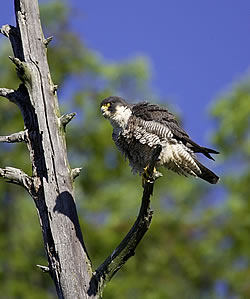by Bruce MacPherson
Driving on the Bolton Notch Road in April is hazardous at best. Peregrine FalconIt's mud season, you know. Still, Shirley Johnson seems to be in control of the vehicle and besides, I'm not looking. Finally, we reach the spot we've been searching for. Chip Wright and Larry Haugh are there already. And a few minutes later Margaret Fowle drives up. We are gathered at the foot of one of the many cliffs visible from the Bolton Notch Road. But this one is special. It has been the site of a Peregrine Falcon nest for the past several years. We are here to receive training from Margaret for the Peregrine Falcon Monitoring Project, the follow up to the Peregrine Falcon Recovery Program that concluded a few years ago.
Peregrine Falcons are amazing birds. They can dive through the air at a speed of more than 200 miles per hour to catch their prey. But not too many years ago the Peregrine Falcon population was decimated by the pesticide DDT. Peregrine Falcons are perched at the top of the food chain. As a result, when DDT seeped into the food chain, it accumulated in the flesh of the falcons. The result was a marked decrease in egg production. DDT caused the eggs to be thin-shelled, fragile, and often non-viable. As time went on the population of Peregrine Falcons dropped precipitously as older birds died and were not replaced by fledged chicks. In fact, the eastern population was entirely eradicated. In the west, fewer than 400 nesting pairs of falcons remained, roughly 10% of the number found in better times.
Enter the U.S. government. In the 1972 the agricultural use of DDT was banned and Peregrine Falcons were placed on the Endangered Species list. In the late 1970's the Peregrine Falcon Recovery Program was begun. Over the next 20 years the Peregrine Falcon population increased dramatically. Currently, there are over 1600 nesting pairs in North America, far exceeding the program's goal of 631 nesting pairs. A few years ago Peregrine Falcons were delisted, but until 2015, there will be a continuing need to monitor the falcon population to be sure that this increase is sustained.
That's where we come in. Margaret tells us that last year there were 38 Peregrine Falcon nesting spots in Vermont. This is one of them. I stare at the face of the cliff. The cliff stares back. I see nothing. Suddenly, Margaret says, "I saw a feather move." Huh! "Up there. To the right of the bush at 1 o'clock, halfway up the cliff." I look through her scope. Sure enough I see the tail of a bird moving up and down. A falcon? Yes! A majestic male falcon flies into view and lands on a snag 25 yards from the nest site. A few minutes later he flies to the nest site. The female immediately flies off. This is what passes for courtship behavior among falcons. For the next few hours we watch the pair fly back and forth putting on a nice aerial show. Margaret patiently educates us on falcon lore, the recovery project, and our role in the monitoring program. We watch and listen.
By 1:30 P.M. it's over. One of the birds has left the site and the other is hidden in a cranny. Peregrine Falcons spend a lot of time conserving energy, Margaret assures us. No matter. We have learned what we need to know.
The next week, and for several weeks thereafter through June and early July we visit Snake Mountain to monitor the falcon’s nest there. Snake Mountain has been a reliable nesting site for falcons since at least 2001. Eric Lazarus, Bill Mercia, and Andrew Webbe lead the charge. The cliff face is visible from the parking lot, but Eric discovers a better spot closer to the mountain. During the season we see the falcons and watch their behavior, but, alas-no nest and no chicks. Finally, we conclude that their nesting attempt has failed. Why? Weather? Poor site selection? Predation? Human disturbance? Who knows. Hopefully, the falcons will be back at Snake Mountain next year and will achieve reproductive success. Hopefully, we will be back there, too, to wait and watch the falcon’s nest.
Photograph of a Female Peregrine Falcon at Fairlee by Steve Faccio.
